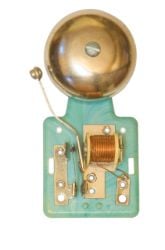Science project
Does Electricity Move Better through Thick Wires or Thin Ones?
Does a wider “road” help electricity flow faster? See whether electricity moves better through thick wires or thin ones.
Problem:
Does electricity move better through thick wires or thin ones?
Materials:
- Plastic straw
- Scissors
- 2 unused D batteries
- Electrical tape
- Steel wool pad
- 2 new flashlight bulbs
Procedure
- Create a hypothesis, your best guess about what is going to happen. Will a circuit with thicker wire work better than one with thinner wire?
- Get your batteries set up on a flat surface. One battery will get thin wire, and the other will get thicker wire.
- To install your wires, cut two pieces of straw that are the same length as the battery. Place the straw lengthwise on the side of the battery, and tape it onto the battery with the electrical tape.
- Your steel wool pad is a good source of wires for your thin wire circuit. Pull it apart and take some strands of steel from the pad. Make a small pile of these on the side of the table.
- Now it’s time to create a conductor, something that helps electricity move from one place to another. Take three strands of steel wool and use your fingers to roll them together into a thin wire. Now, take ten strands of steel wool and roll them together until they make a thicker wire.
- Now you’ll have two wires: one thick, one thin. Put the thin wire through the middle of the straw on one battery, and put the thick wire through the other straw.
- Tape one end of the thin wire to the negative end of the battery (this is the flat end and should have a minus sign on it).
- Wrap the other end of the thin wire around the bottom of one of the flashlight bulbs. Tape it to the bulb with electrical tape, and make sure the bottom part of the bulb is still exposed.
- Now, move the end of the light bulb down until it touches the positive side of the battery (the part that sticks out). If your circuit is complete, the bulb should come on!
- Repeat steps 7-9 with the thicker wire. Which light burns brighter?

Results
The bulb that’s attached to the thicker wire is brighter.
Why?
Imagine a parking lot that’s packed with cars, all waiting to move from one place to another. That’s your battery. Imagine opening up a single lane road. How fast would the cars be able to leave? Now, imagine opening up a four-lane highway attached to the same parking lot. How fast would the cars be able to leave now?
The thin wire will conduct electricity, but there is more electrical resistance. The thicker wire is like the four lane highway. There’s a lot less electrical resistance, and as a result, that light bulb burns brighter because more electricity can reach it.
What do you think would happen if you used a different type of conductor? Does every type of wire move electricity in the same way?
Education.com provides the Science Fair Project Ideas for informational purposes only. Education.com does not make any guarantee or representation regarding the Science Fair Project Ideas and is not responsible or liable for any loss or damage, directly or indirectly, caused by your use of such information. By accessing the Science Fair Project Ideas, you waive and renounce any claims against Education.com that arise thereof. In addition, your access to Education.com's website and Science Fair Project Ideas is covered by Education.com's Privacy Policy and site Terms of Use, which include limitations on Education.com's liability.
Warning is hereby given that not all Project Ideas are appropriate for all individuals or in all circumstances. Implementation of any Science Project Idea should be undertaken only in appropriate settings and with appropriate parental or other supervision. Reading and following the safety precautions of all materials used in a project is the sole responsibility of each individual. For further information, consult your state's handbook of Science Safety.













